آرامگاه شمس تبریزی
معمار: پیمان اسحاقی، مجتبی داوری مجد
موقعیت: خوی، ایران
تاریخ: 1391
مساحت: 7،300 مترمربع
وضعیت: طرح پیشنهادی مسابقه / رتبه ششم
کارفرما: بنیاد شمس تبریزی و مولانا
تیم پروژه: پیمان اسحاقی، مجتبی داوری مجد، مهدی احمدی
شمس تبریزی، به عنوان یکی از عرفای ضد قراردادهای ذهنی، در صدد نشاندادن مفاهیم معنوی و جوهره واقعی بندگی، با شاخصههای شخصیتی همچون پرخاشگر، مهربان و صفتهای فرااخلاقی شناخته میشود. دیدار حضرت شمس تبریزی با مولانا جلالالدین سرآغاز پیدایش آنتیتزی از خود تز بوده است که سنتز این پدیده، هستیشناسی و جهانبینی جدیدی (وحدت وجودی) برای عرفا شد. دیدار حضرت شمس با مولانا موجب دیکانسترهشدن جهانبینی مولانا یا به عبارتی، شالودهشکنی فکری ایشان و باعث ایجاد جریان فکری در عرفان شد. دیدار شمس با مولانا و رابطه عمیق معنوی این دو شخصیت و تاثیر شمس بر مولانا که باعث دگرگونی احوالات مولانا شده و ضرورت روشنگری رابطه این دو شخص در کالبد معماری، بر اساس معیارهای سمبولیک، محوریت ایدهپردازی طرح است.
روند طرح از سه بخش «قبل دیدار»، «حین دیدار» و «بعد دیدار» شمس تبریزی با مولانا شکل گرفته که تاثیرگذاری شمس تبریزی روی مولانا، اساس روند طراحی است. تغییر در هر رویدادی به صورت تدریجی یا دگردیسی اتفاق میافتد و این تحول فکری نیازمند یک بستر است که قابلیت و پتانسیل مفاهیمی را که قبلا در خود به صورت بالقوه داشته، به بالفعل درآورد؛ بستر سایت و ایده طرح، به عنوان کاتالیزوری برای این فرآیند دیالکتیکی عمل میکنند. در بدو سایت، یکی به دل خاک و دیگری به اوج در حال حرکت است که جدل عقل و عشق در اینجا، هم در جهت حرکت و هم در متریال و هم در دوگانگی مسیر دیده میشود؛ در این سرا، بهت و ابهام در دوگانگی این مسیر حس میشود. بستر این پدیده، همان بستر سایت است که هر حرکتی برخاسته از خود سایت و انرژیهای موجود در سایت است که بالقوههای این بستر را به بالفعل تبدیل کند. در این بستر، فضاهای مزبور و مقبره در دل خاک بوده و هرمنوتیک ماده و معنا را که هر پدیده به جوهره خود برمیگردد، متجلی میکند.
شخصیت و تفکر مولانا قبل از دیدار، دارای قراردادهای ذهنی بوده و اندیشه ایشان بر اصول و قراردادهای ذهنی تکیه کرده بود. برای نشاندادن این امر ذهنی و پروسهای که یک معنا طی میکند تا به فرم برسد، از سمبل مکعب، به عنوان نماد عالم مادی و قراردادها استفاده کردیم؛ یعنی شخصیت مولانا همانند قانونمندی مکعب بوده و این دیدار، باعث ایجاد یکسری تفکرات و جنبشهای فکری شده است. موج و حرکت بدو ورود، به طرف فرم مکعب در حال حرکت است و مکعب صلب را تحت تاثیر قرار داده و شالوده آن را عوض و مکعب را احاطه کرده است. این اتفاق، تقابل و در همتنیدگی ماده و معنا را نشان داده و سنتز نیستی و نور را ایجاد کرده است. با خالیشدن درون مکعب، مکعب تبدیلشونده بعد از اتفاق، خود به یک تبدیلکننده مبدل میشود، یعنی مکعب حاصله، محل اتصالدهنده آسمان به زمین است که این برخورد نمادین، همان اتفاق مبهم دیدار را بازگو میکند. حس معلق بودن تفکر مولانا تا رسیدن به ثبات فکری و طریقتی، در شخصیت او جلوهگر بوده و از اینرو، مکعب روی آب قرار داده شد تا حس معلقی در ماده همسنخ خود نشان داده شود.
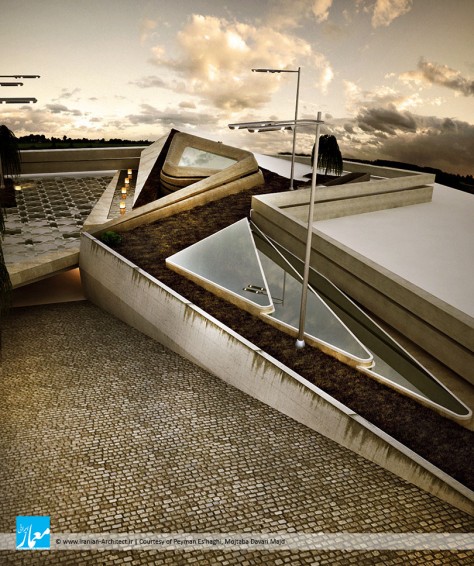
حرکت رو به اوج، به صورت لایهلایه و تدریجی، به طرف مرکز طرح رفته که تغییر شخصیتی به صورت تدریجی را نشان میدهد و این راه، در بالا به طرف آمفیتئاتر و غرب مقبره منتهی میشود. در قسمت شرقی مقبره، در بام آن قسمت، به نقوش اسلیمی هشتپر چلیپایی که نماد خورشید و چلیپا، نماد چهار جهت و لامکانی بوده، اشاره شده است و اینکه اتفاق دیدار به صورت محتوایی، در بستر این فضای کلاسیکی که پوسته سنت بوده و اتصال و رابطه این دو فرم، به صورت ابهامی و طرح سوال اتفاق افتاده است. برای روشنگری هر موضوعی، باید به ریشه و بسترآن رجوع کرد و تقابل آن را نشان داد و این بارزه چندمعنایی، هم در این حرکت و هم در تبدیل مفاهیم به فرم نشان داده شده است.
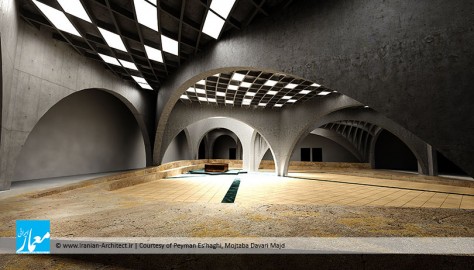
هدف طرح، نشاندادن یک شخصیت، نه به صورت مستقیم، بلکه تداعیکننده آن شخص و دیدار به صورت نمادین است. در کل، ارزشگذاری به یک پدیده محتوایی در قالب فرم و فضا، بر اساس دید مخاطب معنا پیدا میکند و نه این است و نه آنی، همین است و همانی، تاویل مخاطب را دامن میزند. ساختار و ایده طرح، معماری این مقبره را تشکیل داده و این بنا، به دور از هرگونه تزئین و آلایش ایجاد شده است که سادهزیستی شمس را نشان میدهد.
Shams Tabrizi’s Mausoleum
Architect: Peyman Es’haghi, Mojtaba Davari Majd
Location: Khoy, Iran
Date: 2013
Area: 7,300 sqm
Status: Competition Proposal / 6th Place
Client: Shams Tabrizi & Mawlana Foundation
Project Team: Peyman Es’haghi, Mojtaba Davari Majd, Mahdi Ahmadi
Shams Tabrizi, as one of the Gnostic dissent the subjective conventions looking for demonstrating spiritual concepts and real thralldom substance, is known by characteristic particulars, such as kind aggressor and meta-ethical qualities. Meeting of Shams Tabrizi and Mawlana Jalaleddin was an introduction to emergence of an antithesis from the thesis itself. Synthesis of the phenomenon resulted in an ontology and new ideology (pantheist) for Gnostic. The meeting led to deconcentration of Mawlana’s ideology or changing of his mental pattern. It resulted in development of mental flow in mysticism. Meeting of Shams and Mawlana, their deep mental relationship, influence of Shams on Mawlana resulted in his mental variations, and necessity of clarifying their relationship at architectural body, based on symbolic criteria was regarded as ideology fundamentals.
The plan process was consisted of three sectors including before, during, and after meeting of Shams Tabrizi and Mawlana. Influence of Shams Tabrizi on Mawlana is the basis of the planning process. Every event changes gradually. The mental revolution requires conditions to de facto potential and capability of its potential concepts. Site substructure and plan idea serve as a catalyst for the dialectic process. At the beginning of the site, one moves inside of soil and another toward peak. Mind and love dialectic is seen at motion direction, material, and pathway dualistic. Here, ambiguity of pathway dualistic is felt. The phenomenon is rest on the site substructure where every motion raises from the site itself and energies found in the site changing potentials of the conditions to de facto. Here, the mentioned spaces and tomb are located inside the soil. It manifests hormonitic of material and meaning indicating that every phenomenon returns to its substance.
Before meeting, Mawlana’s characteristic and thought had subjective conventions and his thought was relied on subjective principles and conventions. To demonstrate this subjective issue and the process covered by a meaning to reach the form, cubic symbol was used as a sign of material world and conventions. The characteristic is disciplined as a cube and the meeting resulted in developing of a series of thoughts and mental movements. Wave and motion at the entry, moves toward cube form affecting rigid body, changing its pattern, and surrounding the cube. It refers to encounter and interwoven nature of material and meaning and develops light and non-existence synthesis. Voiding the cube, the cube converted after the event, changes to a converter, i.e. the resulted cube indicates to connecting point of heaven and land. This symbolic contact recounts ambiguous event of the meeting. Uncertainty sense of Mawlana’s thought to reach Sufism and mental stability was manifested in his characteristic. For this purpose, the cube was put on water to demonstrate the float sense in its peer material.
The peak motion was in layer and gradual form toward plan center indicating to gradual characteristic variations. The way ends to amphitheater and west of tomb. Crosswise eight-wing Islamic designs respectively indicating to sun and four directions and omnipresent are seen at eastern part of the tomb and its roof. The plan background indicates to randomness of the meeting as the content in this classic space background forming tradition crust and occurring of connectivity and relationship of these two forms as an ambiguous and questioning one. To clarify every subject, its root and background should be considered and its reciprocity should be demonstrated. This multi-semantic feature has been demonstrated in this motion as well as changing concepts to forms.
The most important objective is to manifest a character not in a direct way; rather, in a way symbolically associating the person and meeting. Generally, valuing a contextual phenomenon in the form and space framework will be meaningful based on the partner viewpoint. Neither this is nor that is, Either this is or that is; It aggravates the partner paraphrase. Plan idea and structure constitutes the mausoleum architecture far from any decorations indicating to Shams’ simple life.

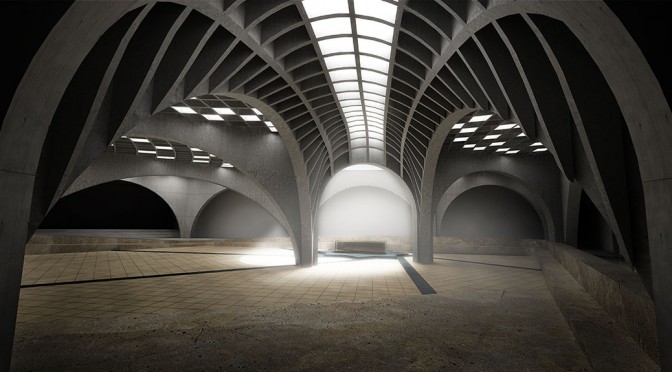
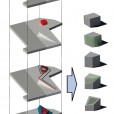
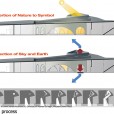
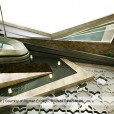



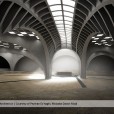
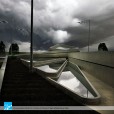

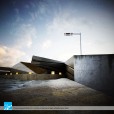
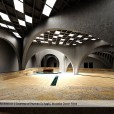

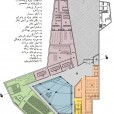

اقایون خسته نباشيد طرح هاتون عالی بود.
کانسپت کار واسه یه معمار تا حدودی تفهیمه. اونم تا حدودی…
حالا عام مردم که مخاطب این مقبره هستن, متوجه نمیشم که چطور قراره بفهمن مکعبه حاصل از پیوند آسمان و زمین است!